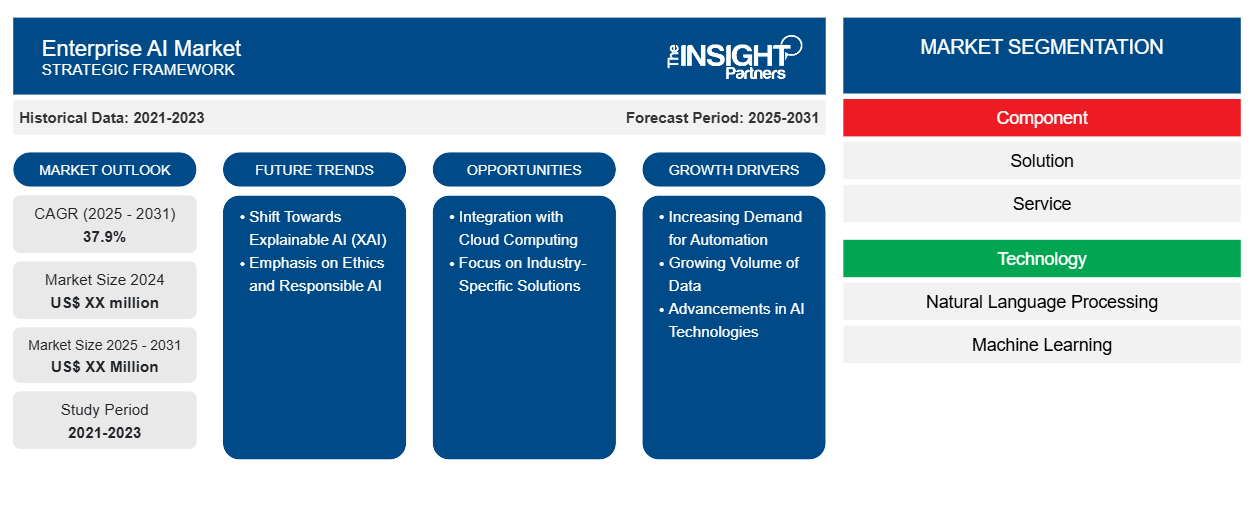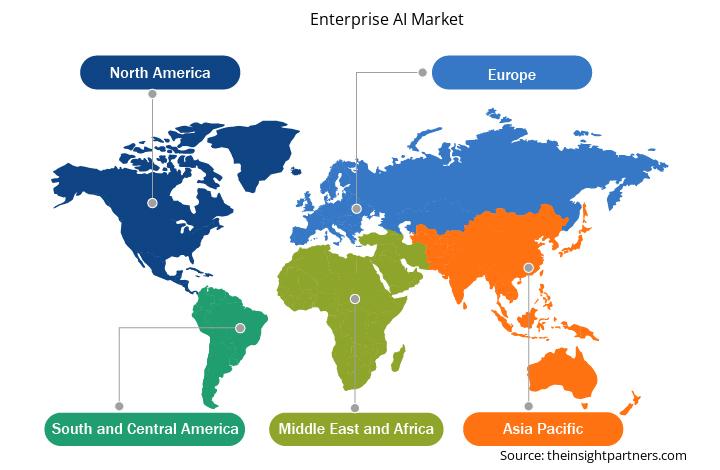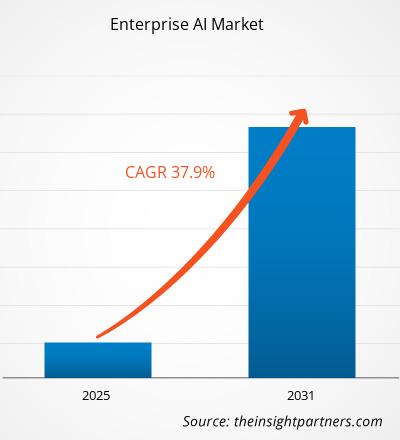من المتوقع أن يسجل سوق الذكاء الاصطناعي للمؤسسات معدل نمو سنوي مركب بنسبة 37.9٪ من عام 2025 إلى عام 2031، مع توسع حجم السوق من XX مليون دولار أمريكي في عام 2024 إلى XX مليون دولار أمريكي بحلول عام 2031.
يُقسّم التقرير حسب المكونات (الحلول، الخدمات)؛ والتكنولوجيا (معالجة اللغات الطبيعية، والتعلم الآلي)؛ والنشر (داخل المؤسسة، والسحابة)؛ وحجم المؤسسة (الشركات الكبيرة، والشركات الصغيرة والمتوسطة)؛ وقطاع المستخدم النهائي (التجزئة، والسيارات، والخدمات المصرفية والمالية والتأمين، وتكنولوجيا المعلومات والاتصالات، والإعلام والإعلان، وغيرها)؛ والتوزيع الجغرافي (أمريكا الشمالية، وأوروبا، وآسيا والمحيط الهادئ، والشرق الأوسط وأفريقيا، وأمريكا الجنوبية والوسطى).
ويُفصّل التحليل العالمي بشكل أكبر على المستوى الإقليمي والدول الرئيسية. ويُقدّم التقرير القيمة بالدولار الأمريكي للتحليل والقطاعات المذكورة أعلاه.
غرض التقرير
يهدف تقرير "سوق الذكاء الاصطناعي للمؤسسات" الصادر عن "ذا إنسايت بارتنرز" إلى وصف المشهد الحالي والنمو المستقبلي، وأهم العوامل المحفزة، والتحديات، والفرص المتاحة. وسيوفر هذا التقرير رؤى ثاقبة لمختلف أصحاب المصلحة في قطاع الأعمال، مثل:
- مزودي التكنولوجيا/المصنعين: لفهم ديناميكيات السوق المتطورة ومعرفة فرص النمو المحتملة، وتمكينهم من اتخاذ قرارات استراتيجية مستنيرة.
- المستثمرون: إجراء تحليل شامل للاتجاهات فيما يتعلق بمعدل نمو السوق، والتوقعات المالية للسوق، والفرص المتاحة عبر سلسلة القيمة.
- الهيئات التنظيمية: لتنظيم السياسات ومراقبة الأنشطة في السوق بهدف تقليل الانتهاكات والحفاظ على ثقة المستثمرين ودعم سلامة السوق واستقرارها.
تجزئة سوق الذكاء الاصطناعي للمؤسسات
عنصر
- حل
- خدمة
تكنولوجيا
- معالجة اللغة الطبيعية
- التعلم الآلي
النشر
- في الموقع
- سحاب
حجم المنظمة
- الشركات الكبيرة
- الشركات الصغيرة والمتوسطة
صناعة المستخدم النهائي
- بيع بالتجزئة
- السيارات
- الخدمات المصرفية والمالية والتأمين
- تكنولوجيا المعلومات والاتصالات
- الإعلام والإعلان
قم بتخصيص هذا التقرير ليناسب متطلباتك
ستحصل على تخصيص لأي تقرير - مجانًا - بما في ذلك أجزاء من هذا التقرير، أو تحليل على مستوى الدولة، وحزمة بيانات Excel، بالإضافة إلى الاستفادة من العروض والخصومات الرائعة للشركات الناشئة والجامعات
سوق الذكاء الاصطناعي للمؤسسات: رؤى استراتيجية

- احصل على أهم اتجاهات السوق الرئيسية لهذا التقرير.ستتضمن هذه العينة المجانية تحليل البيانات، بدءًا من اتجاهات السوق وحتى التقديرات والتوقعات.
محركات نمو سوق الذكاء الاصطناعي للمؤسسات
- تزايد الطلب على الأتمتة: تبحث المؤسسات بشكل متزايد عن طرق لأتمتة المهام الروتينية لتحسين الكفاءة وخفض التكاليف التشغيلية. تُمكّن تقنيات الذكاء الاصطناعي المؤسسات من أتمتة عمليات مثل إدخال البيانات، وتفاعلات خدمة العملاء، وإدارة سلسلة التوريد. هذا الطلب على الأتمتة لا يُعزز الإنتاجية فحسب، بل يُتيح أيضًا للموظفين التركيز على أنشطة أكثر استراتيجية وذات قيمة مضافة. في ظل سعي الشركات لتحقيق التميز التشغيلي، يُعد التوجه نحو الأتمتة عاملاً أساسياً في دفع سوق الذكاء الاصطناعي للمؤسسات إلى الأمام.
- حجم متزايد من البيانات: يُمثل النمو الهائل للبيانات التي تُنتجها الشركات تحدياتٍ وفرصًا في آنٍ واحد. تُغمر المؤسسات بكميات هائلة من البيانات المُهيكلة وغير المُهيكلة من مصادر مُتنوعة، مثل أجهزة إنترنت الأشياء، ووسائل التواصل الاجتماعي، وتفاعلات العملاء. تُعدّ تقنيات الذكاء الاصطناعي، وخاصةً التعلم الآلي، أساسيةً لتحليل هذه البيانات واستخلاص رؤى قيّمة. تُعدّ القدرة على استخدام تحليلات البيانات الضخمة لتوجيه عملية صنع القرار وتوجيه استراتيجيات الأعمال مُحركًا رئيسيًا لسوق الذكاء الاصطناعي للمؤسسات، حيث تسعى الشركات إلى تسخير قوة بياناتها.
- التطورات في تقنيات الذكاء الاصطناعي: تُسهم التطورات السريعة في تقنيات الذكاء الاصطناعي، بما في ذلك التعلم العميق، ومعالجة اللغات الطبيعية، والرؤية الحاسوبية، في جعل حلول الذكاء الاصطناعي أكثر سهولةً وفعالية. تُمكّن هذه التطورات التكنولوجية المؤسسات من تطبيق حلول ذكاء اصطناعي قادرة على أداء مهام معقدة بدقة وكفاءة أعلى. ومع استمرار تحسّن قدرات الذكاء الاصطناعي، يزداد ميل الشركات إلى تبني هذه التقنيات لتعزيز ميزتها التنافسية. ويُعدّ الابتكار المستمر في مجال الذكاء الاصطناعي محركًا أساسيًا لنمو سوق الذكاء الاصطناعي للمؤسسات.
اتجاهات مستقبل سوق الذكاء الاصطناعي للمؤسسات
- التحول نحو الذكاء الاصطناعي القابل للتفسير (XAI): مع تزايد تعقيد أنظمة الذكاء الاصطناعي، يتزايد الطلب على الشفافية وسهولة التفسير في عمليات صنع القرار المتعلقة بالذكاء الاصطناعي. يهدف الذكاء الاصطناعي القابل للتفسير (XAI) إلى جعل نماذج الذكاء الاصطناعي أكثر قابلية للفهم للمستخدمين، مما يتيح لهم فهم كيفية اتخاذ القرارات. يكتسب هذا التوجه أهمية خاصة في القطاعات الخاضعة للتنظيم، مثل الرعاية الصحية والتمويل، حيث يُعد فهم النتائج التي يُحركها الذكاء الاصطناعي أمرًا بالغ الأهمية. يُسهم التحول نحو الذكاء الاصطناعي القابل للتفسير في تشكيل تطوير حلول الذكاء الاصطناعي، حيث تسعى المؤسسات إلى بناء الثقة والمساءلة في تطبيقات الذكاء الاصطناعي الخاصة بها.
- التركيز على الأخلاقيات والذكاء الاصطناعي المسؤول: أدى تنامي تقنيات الذكاء الاصطناعي إلى تزايد المخاوف بشأن الأخلاقيات والتحيز والمساءلة في أنظمة الذكاء الاصطناعي. وتدرك المؤسسات بشكل متزايد أهمية تطبيق المبادئ والممارسات الأخلاقية في تطوير وتطبيق الذكاء الاصطناعي. ويدفع هذا التركيز على الذكاء الاصطناعي المسؤول إلى اعتماد أطر عمل تعزز العدالة والشفافية والمساءلة في تطبيقات الذكاء الاصطناعي. ومع إعطاء الشركات الأولوية للاعتبارات الأخلاقية، ستظل الحاجة إلى ممارسات الذكاء الاصطناعي المسؤولة تُشكل سوق الذكاء الاصطناعي في المؤسسات.
فرص سوق الذكاء الاصطناعي للمؤسسات
- التكامل مع الحوسبة السحابية: يُتيح دمج الذكاء الاصطناعي مع الحوسبة السحابية فرصًا واعدة للشركات. تُوفر منصات الذكاء الاصطناعي السحابية للمؤسسات موارد قابلة للتطوير وإمكانية وصول مرنة إلى أدوات الذكاء الاصطناعي دون الحاجة إلى بنية تحتية محلية واسعة. تُتيح هذه الإمكانية للشركات، بمختلف أحجامها، الاستفادة من تقنيات الذكاء الاصطناعي، مما يُعزز اعتمادها في مختلف القطاعات. كما تُسهّل الحلول السحابية التعاون ومشاركة البيانات، مما يُعزز فعالية تطبيقات الذكاء الاصطناعي. ويُمثل التقارب بين الذكاء الاصطناعي والحوسبة السحابية فرصة واعدة لنمو السوق.
- التركيز على حلول متخصصة: يتزايد الطلب على حلول الذكاء الاصطناعي التي تلبي احتياجات قطاعات محددة، مثل الرعاية الصحية، والتمويل، وتجارة التجزئة، والتصنيع. وتسعى المؤسسات إلى تطبيقات ذكاء اصطناعي مصممة خصيصًا لتلبية تحدياتها ومتطلباتها الفريدة. ومن خلال تطوير حلول متخصصة، يمكن للموردين التميز في سوق تنافسية وتقديم قيمة مضافة لعملائهم. ويمثل التركيز على حلول الذكاء الاصطناعي المخصصة فرصةً واعدةً للنمو في سوق الذكاء الاصطناعي للمؤسسات.
رؤى إقليمية حول سوق الذكاء الاصطناعي للمؤسسات
قام محللو إنسايت بارتنرز بشرح شامل للاتجاهات الإقليمية والعوامل المؤثرة في سوق الذكاء الاصطناعي للمؤسسات خلال فترة التوقعات. ويناقش هذا القسم أيضًا قطاعات سوق الذكاء الاصطناعي للمؤسسات ومناطقها الجغرافية في أمريكا الشمالية، وأوروبا، وآسيا والمحيط الهادئ، والشرق الأوسط وأفريقيا، وأمريكا الجنوبية والوسطى.

- احصل على البيانات الإقليمية المحددة لسوق الذكاء الاصطناعي للمؤسسات
نطاق تقرير سوق الذكاء الاصطناعي للمؤسسات
| سمة التقرير | تفاصيل |
|---|---|
| حجم السوق في عام 2024 | XX مليون دولار أمريكي |
| حجم السوق بحلول عام 2031 | XX مليون دولار أمريكي |
| معدل النمو السنوي المركب العالمي (2025 - 2031) | 37.9% |
| البيانات التاريخية | 2021-2023 |
| فترة التنبؤ | 2025-2031 |
| القطاعات المغطاة | حسب المكون
|
| المناطق والدول المغطاة | أمريكا الشمالية
|
| قادة السوق وملفات تعريف الشركات الرئيسية |
|
كثافة اللاعبين في سوق الذكاء الاصطناعي للمؤسسات: فهم تأثيرها على ديناميكيات الأعمال
يشهد سوق الذكاء الاصطناعي للمؤسسات نموًا سريعًا، مدفوعًا بتزايد طلب المستخدمين النهائيين نتيجةً لعوامل مثل تطور تفضيلات المستهلكين، والتقدم التكنولوجي، وزيادة الوعي بمزايا المنتج. ومع تزايد الطلب، تعمل الشركات على توسيع عروضها، والابتكار لتلبية احتياجات المستهلكين، والاستفادة من الاتجاهات الناشئة، مما يُعزز نمو السوق.
تشير كثافة اللاعبين في السوق إلى توزيع الشركات العاملة في سوق أو قطاع معين. وتشير إلى عدد المنافسين (اللاعبين في السوق) الموجودين في سوق معين نسبةً إلى حجمه أو قيمته السوقية الإجمالية.
الشركات الرئيسية العاملة في سوق الذكاء الاصطناعي للمؤسسات هي:
- شركة ألفابت
- خدمات الويب من أمازون
- شركة هيوليت باكارد لتطوير المشاريع المحدودة
- شركة آي بي إم
- شركة إنتل
- شركة مايكروسوفت
إخلاء المسؤولية : الشركات المذكورة أعلاه ليست مرتبة بأي ترتيب معين.

- احصل على نظرة عامة على أهم اللاعبين الرئيسيين في سوق الذكاء الاصطناعي للمؤسسات
نقاط البيع الرئيسية
- التغطية الشاملة: يغطي التقرير بشكل شامل تحليل المنتجات والخدمات والأنواع والمستخدمين النهائيين لسوق الذكاء الاصطناعي للمؤسسات، مما يوفر مشهدًا شاملاً.
- تحليل الخبراء: تم تجميع التقرير على أساس الفهم العميق لخبراء الصناعة والمحللين.
- معلومات محدثة: يضمن التقرير أهمية الأعمال التجارية بسبب تغطيته للمعلومات الحديثة واتجاهات البيانات.
- خيارات التخصيص: يمكن تخصيص هذا التقرير لتلبية متطلبات العملاء المحددة وتلبية استراتيجيات العمل بشكل مناسب.
لذا، يُمكن لتقرير البحث حول سوق الذكاء الاصطناعي للمؤسسات أن يُساعد في تمهيد الطريق لفهم سيناريوهات هذه الصناعة وآفاق نموها. ورغم وجود بعض المخاوف المُبررة، إلا أن فوائد هذا التقرير الإجمالية تفوق عيوبه.
- التحليل التاريخي (سنتان)، سنة الأساس، التوقعات (7 سنوات) مع معدل النمو السنوي المركب
- تحليل PEST و SWOT
- حجم السوق والقيمة / الحجم - عالمي، إقليمي، بلد
- الصناعة والمنافسة
- مجموعة بيانات إكسل
التقارير الحديثة
تقارير ذات صلة
شهادات العملاء
سبب الشراء
- اتخاذ قرارات مدروسة
- فهم ديناميكيات السوق
- تحليل المنافسة
- رؤى العملاء
- توقعات السوق
- تخفيف المخاطر
- التخطيط الاستراتيجي
- مبررات الاستثمار
- تحديد الأسواق الناشئة
- تحسين استراتيجيات التسويق
- تعزيز الكفاءة التشغيلية
- مواكبة التوجهات التنظيمية




















 احصل على عينة مجانية ل - سوق الذكاء الاصطناعي للمؤسسات
احصل على عينة مجانية ل - سوق الذكاء الاصطناعي للمؤسسات